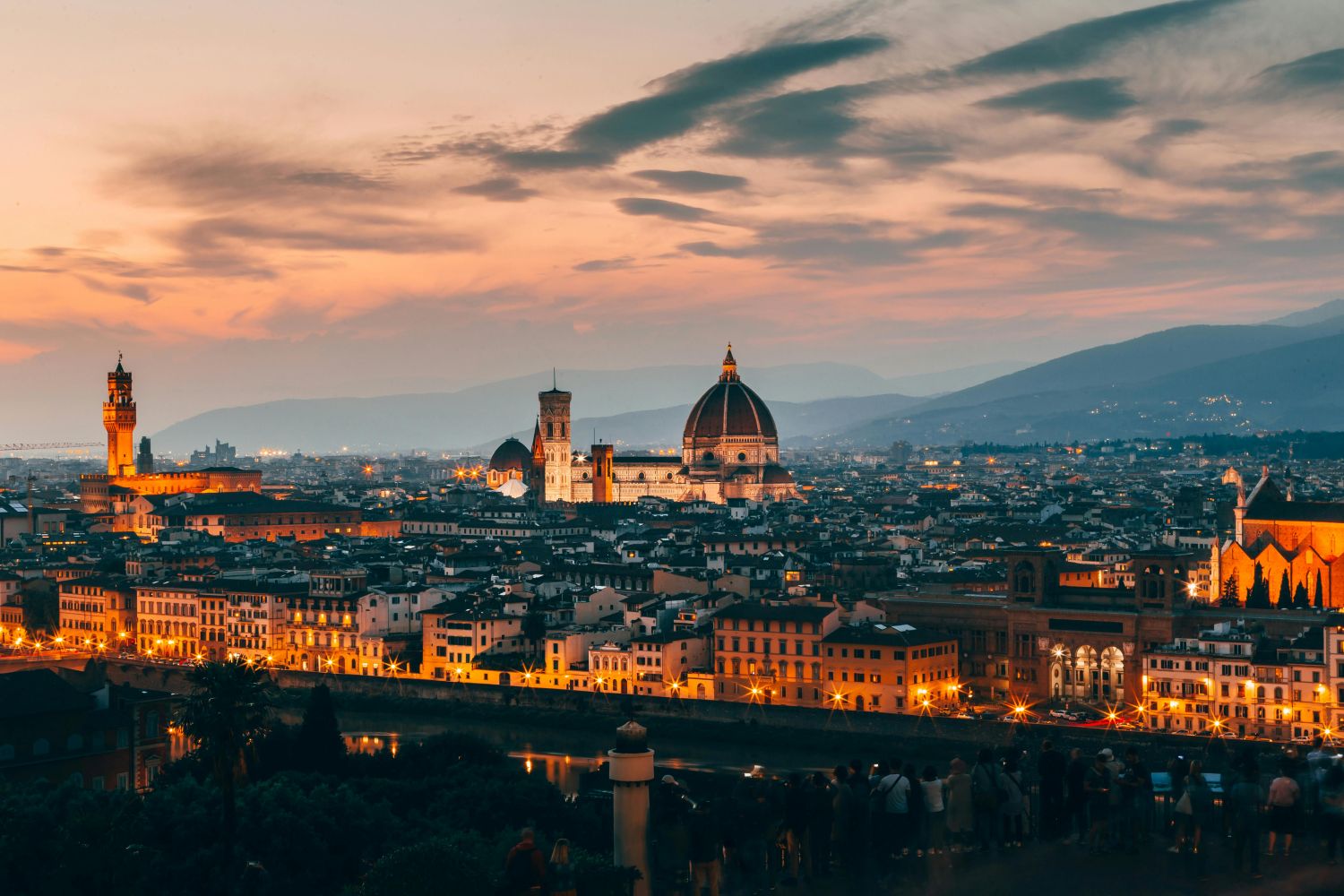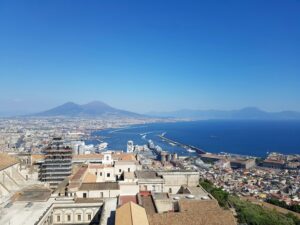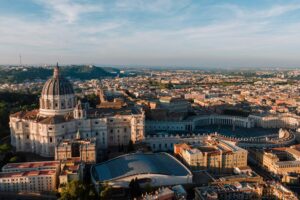Florence travel guide – Welcome to Florence — a city where every cobblestone whispers a Renaissance secret, and every meal feels like a small miracle. Here, the past and present blur so beautifully that you’ll swear time itself pauses. From awe-inspiring art to sun-soaked piazzas buzzing with life, Florence invites you to step into a living masterpiece. Every breath you take feels a little richer, every glance a brushstroke of history and heart.
Table of Contents
Affiliate disclosure: This post may contain affiliate links. If you book or buy something via this Florence travel guide, we may earn a small commission (at no extra cost to you!).
A Quick Dip Into Florence’s History & Culture
This city gave us Michelangelo, Leonardo da Vinci, Botticelli — and it’s still showing off. Here, art and architecture aren’t locked behind museum glass; they casually decorate your daily stroll. Statues, frescoes, and centuries-old churches? Just part of the commute.
Florence owes much of its cultural swagger to the fabulously powerful Medici family, who basically turned being rich into a civic art form. Their patronage helped the city bloom into the Renaissance superstar we still swoon over.
Want the deep dive? Our Florence travel guide uncovers the stories behind iconic spots like the Palazzo Vecchio and the Basilica di Santa Croce — where history doesn’t whisper, it sings.
Neighborhoods You’ll Want to Wander
Florence is a city best explored on foot — and lucky for you, every neighborhood has a personality worth getting lost in. Think of this as your unofficial guide to Florence’s most wander-worthy corners.
Duomo & Centro Storico
Welcome to the historic heart of Florence. This is where you’ll find the jaw-dropping Cathedral of Santa Maria del Fiore (aka the Duomo), Giotto’s Bell Tower, and Piazza della Repubblica humming with energy. Yes, it’s tourist central — but also endlessly photogenic, lively, and iconic. Perfect for first-timers.
Oltrarno
Meaning “beyond the Arno,” this artsy, slightly boho district shows off Florence’s more relaxed, lived-in side. Get lost in narrow streets lined with artisan studios, vintage shops, and quiet piazzas. Highlights? Palazzo Pitti, Boboli Gardens, and the buzz of Piazza Santo Spirito — a local favorite for real-deal trattorias and late-night vibes.
Santa Croce
History buffs, this one’s for you. Home to the grand Basilica di Santa Croce — final resting place of Michelangelo, Galileo, and Machiavelli — this neighborhood blends legacy with leather markets and some of the best gelato in town. It’s lively, central, but just enough off the beaten path.
San Lorenzo & San Marco
If food and markets are your thing, head here. San Lorenzo Market is a paradise of Tuscan treats and leather everything. Just around the corner, the Medici Chapels deliver serious architectural drama. San Marco? Quieter, more reflective, and home to some stunning frescoes by Fra Angelico.
Campo di Marte
No tourist crush here — just local life. This residential neighborhood is great if you want a peek at everyday Florence. It’s also home to Artemio Franchi Stadium (check for matches), tree-lined streets, and the kind of calm you’ll crave after museum overload.
Each area offers a totally different side of the city. Mix and match your wandering, and your Florence travel guide will write itself, one cobbled street at a time.flipping through a vivid, centuries-old travel diary.
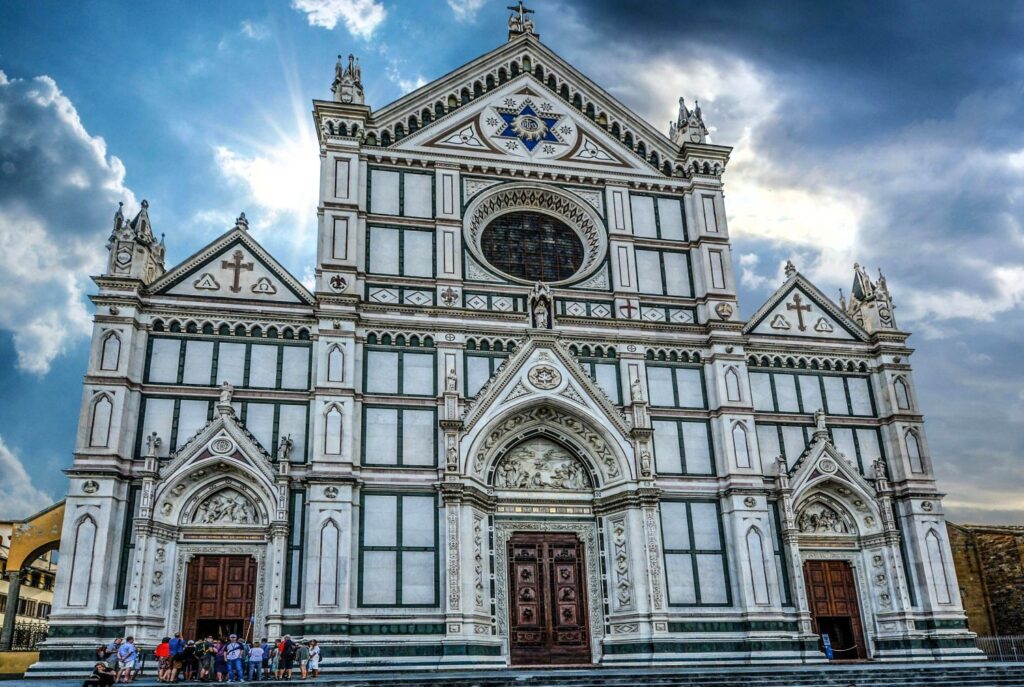
Top Things To Do | Florence Travel Guide
- Climb Brunelleschi’s Dome: The view from the top is breathtaking. Skip the line with GetYourGuide.
- See David: Michelangelo’s masterpiece in the Accademia Gallery. Reserve entry with Viator.
- Lose Yourself in the Uffizi: Botticelli’s “Birth of Venus” and so much more. Timed tickets from Trip.com.
- Sunset at Piazzale Michelangelo: Bring a bottle of wine, watch the skyline turn gold.
- Boboli Gardens: Renaissance splendor outdoors — sculptures, fountains, and all.
- Palazzo Pitti: Grandiose halls filled with priceless art collections.
- Basilica of Santa Maria Novella: Gothic architecture and iconic frescoes.
- San Lorenzo Market: Leather, local food, and vibrant Florentine life.
Epic Day Trips from Florence
Florence may feel like a world unto itself, but it’s also the perfect launchpad for unforgettable Tuscan adventures. Whether you’re chasing medieval towers, sipping wine in the countryside, or dipping your toes in the Ligurian Sea, this Florence travel guide has your escape route sorted.
Pisa
Yes, the tower really leans. But there’s more to Pisa than a photo op. Take time to explore the cathedral, baptistery, and charming streets nearby. Easy train rides and guided tours make it a hassle-free half-day trip.
Chianti Wine Region
Calling all wine lovers: this is your Tuscan dreamscape. Rolling vineyards, stone hamlets, cypress trees — and Chianti Classico flowing freely. It’s the kind of place where one long lunch turns into a life decision.
Cinque Terre
Need some sea air? Hop a train to these five candy-colored cliffside villages. You can hike, swim, eat absurdly fresh seafood, or just sit and stare. Travel time is 2–2.5 hours, so pack comfy shoes and a portable appetite.
Siena & San Gimignano
Siena gives you soaring Gothic architecture and a shell-shaped piazza, while San Gimignano feels like a medieval movie set — complete with ancient towers and some next-level saffron gelato. Together, they make an iconic day out.
Val d’Orcia
If you’ve ever seen a postcard of Tuscany, chances are it was taken here. Golden hills, winding roads, vineyard views for days — this is Tuscany turned up to 11.
Arezzo
Underrated and uncrowded, Arezzo is all about antique markets, frescoes, and laid-back vibes. It’s the perfect slow-day getaway from Florence.
Whether you’ve got one day or five to spare, these side trips round out any Florence travel guide with a splash of countryside magic.
Explore more day trip ideas at Visit Tuscany
Where to Eat & Drink
No Florence travel guide would be complete without diving fork-first into the city’s food scene. From street-side sandwiches to candlelit trattorias, Florence serves up serious flavor at every turn.
All’Antico Vinaio
You can’t miss it — the queue wraps around the block, but it moves fast. This legendary sandwich shop piles on salty meats, creamy cheeses, and tangy spreads with reckless, delicious abandon.
Gelateria dei Neri
Pistachio. Dark chocolate. Existential gelato joy. This place might just convince you that life is better frozen and in a cone.
Trattoria ZaZa
Tuscan comfort food in a buzzing atmosphere. Go for the truffle pasta — no, really — and maybe pair it with a carafe of local red. Regret nothing.
La Giostra
Twinkling lights, royal-level recipes, and a touch of magic. It’s not cheap, but it is unforgettable.
Osteria Santo Spirito
Homey, soulful, and low-key romantic. Expect ribollita, pappa al pomodoro, and that cozy, “we found a local spot” feeling.
Ditta Artigianale
Florence’s answer to third-wave coffee. Great espresso, solid brunch, and prime people-watching.
Procacci
Tiny truffle sandwiches served with serious swagger. Ideal for a fancy snack or edible souvenir.
Il Santo Bevitore
Rustic Tuscan dishes with a fine-dining edge. Perfect for a slow dinner with good wine and zero rush.
Discover Florence’s full food scene on Trip.com
How to Get Around
Florence is built for explorers. The best way to see it? On foot. Most major sights are within walking distance, and the narrow streets are full of hidden gems, so get lost on purpose.
Prefer two wheels? Bike rentals and shares are available across the city — a fun way to cruise along the Arno or reach quieter corners.
If your legs need a break, hop on a tram or bus. Florence has a clean, efficient public transport system that connects neighborhoods and nearby towns. Tickets are cheap and easy to buy at tobacco shops or via mobile apps.
Taxis are available at designated stands or via local apps like ItTaxi. They’re reliable but can be pricey, especially late at night or on weekends.
For longer trips, the city’s central station, Santa Maria Novella, connects you to Rome, Milan, Venice, and beyond. . High-speed trains like Frecciarossa and Italo also operate here, providing fast, comfortable travel to other Italian cities.
Thinking of exploring the countryside? and head for the hills. Just beware of ZTL (limited traffic zones) in the city center — fines are no joke. Cameras enforce these zones automatically, and fines are mailed internationally, even months later.
Florence Travel Guide: Seasonal Travel Tips
Florence changes with the seasons, and each one brings a different kind of magic.
Spring (March–May) is arguably the best time to visit. The weather is warm but not sweltering, flowers are blooming, and the city hosts several outdoor festivals. You’ll enjoy lighter crowds and ideal sightseeing temperatures.
Summer (June–August) is peak tourist season, and also the hottest. Expect packed museums, long lines, and midday heat. That said, there’s a vibrant energy and plenty of outdoor events. Just be sure to hydrate and plan indoor attractions during the heat of the day.
Fall (September–November) brings cooler air, fewer crowds, and a golden light that makes every photo pop. It’s also wine harvest season in Tuscany, so day trips to the countryside are extra special.
Winter (December–February) is the quietest time of year. You’ll find shorter lines, festive lights around Christmas, and great hotel deals. It can be chilly, but Florence without the crowds feels almost like a local secret.
No matter when you go, Florence delivers.
Tips for First-Time Visitors
- Book major attractions in advance: The Uffizi, Accademia, and Duomo fill up quickly. Don’t waste time in line.
- Wear comfortable shoes: Florence is a walking city and its cobblestone streets are charming but hard on your feet.
- Learn a few Italian basics: A simple “buongiorno” or “grazie” goes a long way with locals.
- Respect dress codes: Many churches require modest attire — cover shoulders and knees.
- Watch out for pickpockets: Especially in crowded areas like train stations and popular piazzas.
- Don’t over-plan: Leave time to wander. Some of the best moments happen spontaneously.
- Understand meal timing: Dinner typically starts around 7:30 or 8pm. Restaurants may close between lunch and dinner.
- Carry cash: Many smaller shops and trattorias still prefer it.
- Take breaks: Whether it’s a midday espresso or an hour on a shady bench, slowing down is part of the Florentine rhythm.
- Embrace aperitivo: Around 6–8pm, bars offer light snacks with drinks. It’s delicious, affordable, and a beloved local tradition.
Useful Information
Planning a smooth trip to Florence is easier when you know where to look. Here are some helpful resources to get you started:
- Visit Florence Official Site: The city’s own tourism board with current events, guides, and planning tools.
- Visit Tuscany: Your gateway to wider regional adventures — from wine trails to hill towns.
- Italian National Tourist Board: Nationwide travel tips, regional overviews, and inspiration.
- Ticketmaster: Book concerts, opera, and festivals happening in Florence.
- Vrbo: Find short-term vacation rentals in historic buildings and family-sized apartments.
- Expedia: Great for flight + hotel packages, especially if you’re flying into Florence or nearby cities.
Save these for reference before and during your trip!
Fun Facts
- Florence was the first city in Europe to pave its streets — way back in 1339.
- Carlo Collodi, the author of Pinocchio, was born just outside Florence. There’s even a Pinocchio Park dedicated to his story.
- The piano was invented in Florence in the early 1700s by Bartolomeo Cristofori.
- The city’s historic center is a UNESCO World Heritage Site — and it takes just minutes of walking to understand why.
- Florence has more art per square meter than almost any other city on Earth.
This place doesn’t just wear its history — it lives it.
Florence FAQs
1. Is Florence walkable?
Yes! The city is compact and designed for pedestrians. Most major sights are within a 20-minute walk.
2. How many days should I spend in Florence?
Three to four days will let you hit the highlights and enjoy the vibe without rushing.
3. Can I visit the Leaning Tower of Pisa from Florence?
Absolutely. It’s about 50 minutes away by train — perfect for a half-day trip.
4. What’s the best time to visit Florence?
Spring and fall are ideal for weather, light crowds, and gorgeous golden light.
5. Do I need to book museums ahead of time?
Yes, especially for the Uffizi and Accademia. Walk-up tickets often sell out.
6. Is Florence safe for solo travelers?
Very safe. Just keep an eye on your belongings in busy areas.
7. Where can I store luggage in Florence?
Use Radical Storage to find luggage drop points across the city.
8. Should I tip in Florence?
Tipping isn’t required, but rounding up or leaving 5–10% for great service is appreciated.
9. Is Florence expensive?
It can be, but smart choices (like eating where locals do) can stretch your budget far.
10. Can I drive in Florence?
Technically, yes. But the ZTL (limited traffic zone) is confusing and fines are steep. Stick to trains, taxis, or walking unless you’re heading out of town.
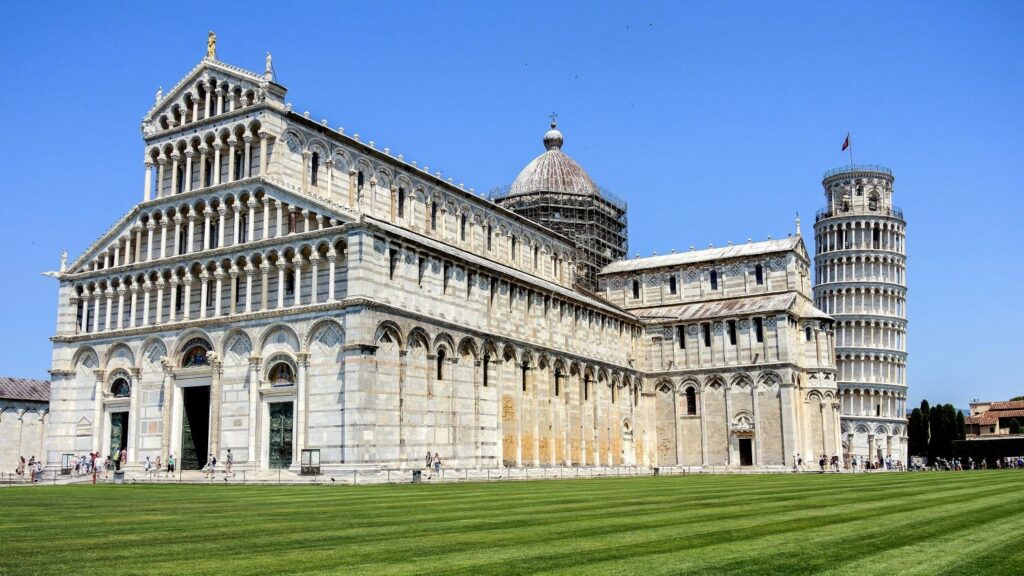
Final Word
Florence isn’t just another city to tick off your bucket list. It’s a place that seeps into your senses and stays there. It’s in the scent of fresh focaccia wafting down a quiet alleyway. It’s in the echo of a violinist playing under the Loggia dei Lanzi. It’s in the heat of a Tuscan sunset hitting the Arno River just right. This is a city that doesn’t show itself all at once — it invites you in slowly, corner by corner, piazza by piazza.
Whether you spend your days marveling at masterpieces, sipping wine in a shaded courtyard, or simply sitting still in a church older than your entire country, Florence makes you feel something. Maybe it’s awe. Maybe it’s joy. Maybe it’s just the pleasure of being fully present.
And if you’re anything like the rest of us, you’ll leave planning your return before you’ve even said goodbye.
Related Posts
Top Things to Do in Naples Italy – Best Attractions & Hidden Gems


